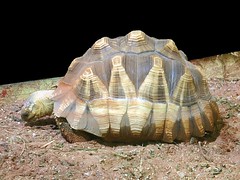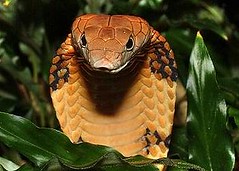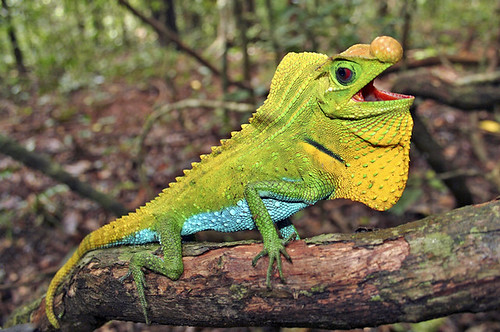第一份全球爬蟲類滅絕風險分析報告在15日發表,其中指出,爬蟲類雖然不夠可愛,也不像熊貓般令人喜愛、又沒有老虎的魅力,不過許多爬蟲類由於人類活動面臨滅絕的風險。
科學家們藉由評估隨機抽出的1500種爬蟲類保育現況,估計全球爬蟲類已知的9084種約有19%受到滅絕的壓力。
熱帶地區爬蟲類棲地因伐木或轉為農業用地,受威脅的程度特別高。
這篇論文由倫敦動物學會及IUCN物種存續委員會的專家們撰寫,發表於《生物保育》(Biological Conservation)期刊,全球共有200位科學家參與這項研究。
IUCN物種存續委員會蛇及爬蟲類紅皮書協調者Philip Bowles表示,「這是評估全球爬蟲類的保育現狀非常重要的一步。調查結果為爬蟲類現況及牠們所面臨高昇的威脅敲響警鐘。處理及識別包括棲地喪失及過度捕捉等威脅,為扭轉爬蟲類下降現況的優先保育對策。」
 爬蟲類包含了海龜、陸龜、蜥蜴、蛇及蚓蜥(蜥蜴和蛇類沒有腳的近親)。也包含鱷魚,雖然就基因而言,比起爬蟲類鱷魚更近鳥類。事實上,地球上最大的爬蟲類是住在澳洲北部、東南亞及部分太平洋島嶼的鹹水鱷。
爬蟲類包含了海龜、陸龜、蜥蜴、蛇及蚓蜥(蜥蜴和蛇類沒有腳的近親)。也包含鱷魚,雖然就基因而言,比起爬蟲類鱷魚更近鳥類。事實上,地球上最大的爬蟲類是住在澳洲北部、東南亞及部分太平洋島嶼的鹹水鱷。
紐西蘭特有的鱷蜥(Tuatara)是種特別的爬蟲類,雖然牠看起來很像多數的蜥蜴,但事實上牠自己是個獨立分支,屬於喙頭目(Rhynchocephalia)。
在爬蟲類總數的19%面臨滅絕威脅的種類中,有12%歸類於極危(Critically Endangered),41%歸類於瀕危(Endangered),47%歸類於易危(Vulnerable)。
淡水龜面臨特別高的風險,全球的淡水生物多樣性都面臨高度威脅。
整體來說,這項研究估計30%的淡水爬蟲類瀕臨滅絕,如果只考慮淡水龜的話數字則會上升為50%,牠們都受到國內及國際交易影響。
科學家們相信,其中三種極危的爬蟲類已經滅絕。
其中之一是南美叢林蜥(Ameiva vittata),只有在波利維亞的小部分區域被紀錄過。由於棲地幾乎被破壞殆盡,近期兩次針對該物種的搜尋都沒有結果。
 論文主要作者Monika Böhm博士表示:「爬蟲類常棲息於極端環境或是嚴苛的環境條件下,所以很容易被誤認為在多變的世界中牠們能適應得很好。但許多物種已高度適應其日常棲地與氣候條件,這導致牠們對環境的改變分外敏感。」
論文主要作者Monika Böhm博士表示:「爬蟲類常棲息於極端環境或是嚴苛的環境條件下,所以很容易被誤認為在多變的世界中牠們能適應得很好。但許多物種已高度適應其日常棲地與氣候條件,這導致牠們對環境的改變分外敏感。」
雖然這是具有全球代表性的研究,作者群表示需要更多的研究來填補這些物種資訊的空白處。
IUCN於2011年表示,爬蟲類鮮少出現於IUCN紅皮書中,只有35%已知種類被評估過,且這些評估以非系統方式進行。
作者群表示,雖然全球爬蟲類評估(Global Reptile Assessment)終究將解決這個偏差,針對特定的爬蟲類的評估目前仰賴區域性的工作坊及IUCN SSC專家小組團隊。
全球爬蟲類評估已經對北美、馬達加斯加、新喀里多尼亞(New Caledonia)進行全面性評估;對菲律賓、歐洲及特定的島嶼群(塞席爾群島、科摩羅和索科特拉島)完成區域性評估。而還有大範圍的空白處待填補,包括非洲、拉丁美洲、亞洲還有澳洲。
作者群寫道:「我們的結果凸顯聚焦於面臨最劇烈的棲地喪失的熱帶地區、長期缺乏資料的掘土性爬蟲、由於族群訊息缺乏長期被低估特定類群如蛇類等項目研究的重要性。」
作者群同時警告,爬蟲類及兩棲類過去在保護策略選擇中極端被忽視,敦促劃設保護區時應將這些物種納入考量。
倫敦動物學會的指標及評估部門領導人Ben Collen博士表示:「為確保爬蟲類的續存,知識的不足與有效保護行動的缺失需要解決。這些發現為儘快制訂重要的保護決策提供捷徑,並將爬蟲類納入保育地圖。」
IUCN瀕危物種紅皮書為全球對動植物保護現狀提供最全面訊息。它基於客觀的系統評估物種滅絕的風險及是否該採取保育行動。
藉由物種的族群趨勢、族群規模及結構與地理分佈,將物種分到1-8不同威脅等級。紅皮書中如極危、瀕危、易危都是對威脅狀態的描述。
IUCN紅皮書包含受威脅的物種、其生態需求、他們的住所及用於減少或防止物種滅絕的保育行動等訊息。
IUCN 紅皮書由IUCN物種存續委員會與紅皮書伙伴國際鳥盟、國際植物園保育協會、國際保育協會、微軟自然服務協會、克佑皇家植物園、羅馬大學 (Sapienza University of Rome)、德州農工大學、野望(Wildscreen)及倫敦動物學會共同推動。
They may not be cute and cuddly like pandas, nor charismatic like tigers, but many reptiles, too, are at risk of being wiped out by human activities, finds the first global analysis of extinction risk in reptiles, published Friday.
The scientists who assessed the conservation status of 1,500 randomly selected reptiles estimate that 19 percent of the world's 9,084 known species of reptiles are threatened with extinction.
Levels of threat remain particularly high in tropical regions as reptile habitat is converted to agriculture and logging.
The paper by the Zoological Society of London with experts from the International Union for the Conservation of Nature Species Survival Commission is published in the journal of "Biological Conservation." Some 200 scientific experts from around the world contributed to the study.
"This is a very important step towards assessing the conservation status of reptiles globally," says Philip Bowles, coordinator of the Snake and Lizard Red List Authority of the IUCN Species Survival Commission.
"The findings sound alarm bells about the state of these species and the growing threats that they face," said Bowles. "Tackling the identified threats, which include habitat loss and over-harvesting, are key conservation priorities in order to reverse the declines in these reptiles."
The class of reptiles takes in turtles and tortoises, lizards and snakes and Amphisbaenia, a legless group of animals closely related to lizards and snakes.
It also includes crocodiles, although they are genetically closer to birds than to other reptiles. In fact, the largest reptile on Earth is the sea-faring saltwater crocodile, which lives in northern Australia, Southeast Asia and on some Pacific islands.
A unique reptile is the Tuatara, an animal endemic to New Zealand which, though it resembles most lizards, is actually part of a distinct lineage, order Rhynchocephalia.
Out of the 19 percent of reptiles threatened with extinction, 12 percent are classified as Critically Endangered, 41 percent are considered Endangered and 47 percent are Vulnerable.
Freshwater turtles are at particularly high risk, mirroring greater levels of threat in freshwater biodiversity around the world.
Overall, the study estimated 30 percent of freshwater reptiles to be close to extinction, a percentage which rises to 50 percent when considering freshwater turtles alone, as they are also affected by national and international trade.
Three Critically Endangered reptile species may already have gone extinct, the scientists believe.
One of these, a jungle runner lizard, Ameiva vittata, has only been recorded in one part of Bolivia. With the lizard's habitat virtually destroyed, two recent searches for the species have been unsuccessful.
"Reptiles are often associated with extreme habitats and tough environmental conditions, so it is easy to assume that they will be fine in our changing world," says Dr. Monika Böhm, lead author on the paper. "However, many species are very highly specialized in terms of habitat use and the climatic conditions they require for day to day functioning. This makes them particularly sensitive to environmental changes."
While this is a globally representative study, the authors say more research is needed to close wide gaps in information about these species.
As a group, reptiles are poorly represented on the IUCN Red List of Threatened Species, with only 35 percent of described species evaluated, and those that are evaluated were done so in a nonsystematic manner, the IUCN said in 2011.
Although the Global Reptile Assessment will in the long run address this bias, the authors say, the current assessment process relies on regional workshops and the formation of IUCN SSC Specialist Groups for specific reptiles.
The Global Reptile Assessment has carried out comprehensive assessments for North America, Madagascar and New Caledonia, with complete endemic-only assessments having been carried out in the Philippines, Europe and selected island groups – the Seychelles, Comoros and Socotra. There are still large geographical gaps which are only slowly being addressed, namely in Africa, Latin America, Asia and Australia.
The authors write, "Our results emphasize the need for research attention to be focussed on tropical areas which are experiencing the most dramatic rates of habitat loss, on fossorial reptiles for which there is a chronic lack of data, and on certain taxa such as snakes for which extinction risk may currently be underestimated due to lack of population information."
Both reptiles and amphibians have been "greatly overlooked in reserve selection strategies," the authors warn, urging that these species be considered when protected areas are set aside.
"Gaps in knowledge and shortcomings in effective conservation actions need to be addressed to ensure that reptiles continue to thrive around the world," says Dr. Ben Collen, who heads the Zoological Society of London's Indicators and Assessment Unit. "These findings provide a shortcut to allow important conservation decisions to be made as soon as possible and firmly place reptiles on the conservation map."
The IUCN Red List of Threatened Species is the world's most comprehensive information source on the global conservation status of plant and animal species. It is based on an objective system for assessing the risk of extinction of a species should no conservation action be taken.
Species are assigned to one of eight categories of threat based on whether they meet criteria linked to population trend, population size and structure and geographic range. Species listed as Critically Endangered, Endangered or Vulnerable are collectively described as Threatened.
The IUCN Red List contains information on the threats to the species, their ecological requirements, where they live, and information on conservation actions that can be used to reduce or prevent extinctions.
The IUCN Red List is a joint effort between the IUCN and its Species Survival Commission, working with its Red List partners BirdLife International; Botanic Gardens Conservation International; Conservation International; Microsoft, NatureServe; Royal Botanic Gardens, Kew; Sapienza University of Rome; Texas A&M University; Wildscreen; and Zoological Society of London.







